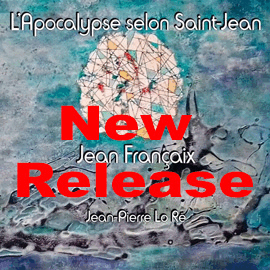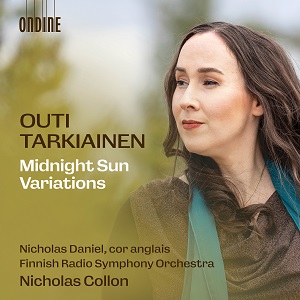Outi Tarkiainen aus der samischen Region Finnlands sieht ihre Werke als Zeugnis der Welt um sie herum. Sie sieht Musik als eine Naturgewalt, die einen Menschen überfluten und sogar Schicksale verändern kann. Mit ihren Werken schafft sie enge Verbindungen zur Natur. Bei den eingespielten Stücken besteht die Verbindung auch zu einem weiteren speziellen Aspekt, nämlich ihrer eigenen Mutterschaft mit den Momenten rund um die Geburt.
Die Komponistin, in ihrem vierten Lebensjahrzehnt, erklärt diese Bindung aus ihrer Herkunft im hohen Norden, in dem die Natur ungleich lebensbestimmender ist. Zyklen wie Jahreszeiten oder Lebensläufe sind ständige Begleiter und untrennbar mit dem Individuum verknüpft. Musikalisch drückt sie das so aus, dass ihre Musik von organischen Prozessen und Prinzipien wie Variationen, wenn auch nicht unbedingt im musikhistorischen Sinne, abläuft, ohne spezifisch programmatisch zu sein.
Midnight Sun Variations handelt vom Licht bzw. von dessen monatelanger Abwesenheit und demonstriert ihren Umgang mit Klangfarben, der sich in einem enormen Reichtum und einer großen Bandbreite an Kolorierungen manifestiert.
Als Geschwisterwerk dazu ist Songs of the Ice zu sehen. Das zu hörende Naturphänomen ist das den jahreszeitlichen Schwankungen unterliegende Eis, womit vor dem Hintergrund des Klimawandels, ein zerbrechlicher Moment ins Spiel kommt. Beide Werke können getrennt oder zusammen in beliebiger Reihenfolge gehört werden. Hier beschreibt die Komponistin auch die Leere und den Prozess des Wiederverschließens, der im Körper einer Frau beginnt, wenn sie sich bei der Geburt von dem Leben in ihr trennt.
Bei dem Ring des Feuers und der Liebe ist die Verbindung zwischen dem geothermischen und der menschlichen Geburt eines Kindes thematisiert. Der Begriff meint den den Pazifik umgebenden Vulkangürtel, ebenso den hellen Ring aus Sonnenlicht um den Mond bei einer ringförmigen Sonnenfinsternis mit nur zentraler Verdeckung. Und drittens beschreibt er das Gefühl einer Frau, wenn bei der Geburt der Kopf des Kindes durch ihr Becken tritt.
Hier ihr jüngstes Werk, Milky Ways, hat einen schamanischen Einschlag. Es ist dem Oboisten Nicholas Daniel gewidmet, der das Englischhorn bläst. Als ‘Spur des Vogels’ zeichnete für die alten Finnen die Milchstraße den Flug des heiligen Schwans über den Himmel zur jenseitigen ‘Heimat der Vögel’. Der Titel ist auch wörtlich für das Stillen eines Säuglings zu verstehen, zugleich nährende Lebenskraft wie auch Moment größter Zärtlichkeit. Der hypnotische Klang des Englischhorns trägt von Mutter Erde zur himmlischen Milchstraße.
In ihren eruptiven Augenblicken ist die Musik von Outi Tarkiainen durchaus als Fortführung der Werke bekannter zeitgenössischer nordischer Komponisten zu verorten. In den feinen Momenten wird eine neue Stimme vernehmbar, die mit oszillierenden Klangwelten auch Gedanken an am Himmel changierendes Nordlicht oder skandinavische Landschaften denken lässt. So kann man die Naturverbundenheit der Musik leicht nachvollziehen. Modern kühl im Ton, aber immer nahbar und voller klanglicher Ideen bietet die Musik von Kartiainen eine Horizonterweiterung der sanglichen Art an, auch ein Ausdruck der Naturnähe.
Das finnische Radio Sinfonie Orchester unter seinem Chef Nicholas Collon verfügt über alle Qualitäten und Erfahrungen, um die Gedanken- und Gefühlswelt in packende Interpretationen zu gießen, die die Farben und Stimmungen in einwandfreier Spielweise transportiert. Collon vermittelt seinem Orchester die Zeichengebung, die es alle Feinheiten der Stücke aufgreifen und effektvoll, aber auch mit sensitiver Zuwendung, gestalten lässt.
Solist Nicholas Daniel spielt dieses auch im Andenken an seine Mutter geschaffene Werk mit einer technischen Reife und sensiblen musikalischen Ausformung, die den persönlichen Hintergrund, auch wenn man nicht um ihn wüsste, erkennbar macht. Gleichzeitig ist Milky Ways mit seinen drei Sätzen ein bereicherndes Konzert für das Soloinstrument, das in dieser Prominenz selten zum Einsatz kommt.
Outi Tarkiainen from the Sami region of Finland sees her works as a testimony to the world around her. She sees music as a force of nature that can flood a person and even change destinies. With her works, she creates close connections to nature. In the pieces she has recorded, there is also a connection to another special aspect, namely her own motherhood and the moments surrounding childbirth.
The composer, in her fourth decade of life, explains this connection from her origins in the far north, where nature is far more decisive for life. Cycles such as the seasons or the course of life are constant companions and inextricably linked to the individual. Musically, she expresses this in such a way that her music is based on organic processes and principles such as variations, even if not necessarily in the music-historical sense, without being specifically programmatic.
‘Midnight Sun Variations’ is about light, or rather its absence for months on end, and demonstrates her approach to timbre, which manifests itself in an enormous richness and wide range of coloration.
‘Songs of the Ice’ can be seen as a sibling work to this. The natural phenomenon to be heard is ice, which is subject to seasonal fluctuations, bringing a fragile moment into play against the backdrop of climate change. Both works can be heard separately or together in any order. Here, the composer also describes the emptiness and the process of re-closure that begins in a woman’s body when she separates from the life within her at birth.
‘The Ring of Fire and Love’ thematizes the connection between the geothermal and the human birth of a child. The term refers to the volcanic belt surrounding the Pacific Ocean, as well as the bright ring of sunlight around the moon during an annular solar eclipse with only a central occultation. And thirdly, it describes the feeling of a woman when the child’s head passes through her pelvis during childbirth.
Her most recent work, Milky Ways, has a shamanic feel to it. It is dedicated to the oboist Nicholas Daniel, who plays the cor anglais. For the ancient Finns, the Milky Way marked the flight of the sacred swan across the sky to the ‘home of the bird’ beyond. The title can also be understood literally as the nursing of a baby, both a nourishing life force and a moment of great tenderness. The hypnotic sound of the English horn carries us from Mother Earth to the heavenly Milky Way.
In its eruptive moments, Outi Tarkiainen’s music can certainly be seen as a continuation of the works of well-known contemporary Nordic composers. In the finer moments, a new voice becomes audible, whose oscillating soundscapes evoke thoughts of the Northern Lights changing in the sky or Scandinavian landscapes. This makes it easy to understand the music’s connection to nature. Modern and cool in tone, but always approachable and full of tonal ideas, Kartiainen’s music offers a broadening of horizons in a vocal way, also an expression of closeness to nature.
The Finnish Radio Symphony Orchestra under its conductor Nicholas Collon has all the qualities and experience to pour the world of thoughts and emotions into gripping interpretations that convey the colors and moods in flawless playing. Collon gives his orchestra a sense of direction that allows it to pick up on all the subtleties of the pieces and shape them effectively, but also with sensitive attention.
Soloist Nicholas Daniel plays this work, which was also created in memory of his mother, with a technical maturity and sensitive musical shaping that makes the personal background recognizable, even if one did not know about it. At the same time, Milky Ways, with its three movements, is an enriching concerto for the solo instrument, which is rarely used in such prominence.





















